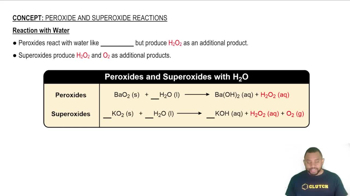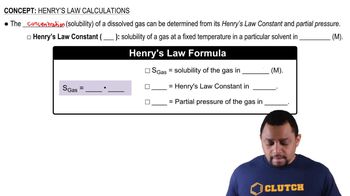The structures of vitamins E and B6 are shown below. Predict which is more water soluble and which is more fat soluble. [Section 13.3]
You take a sample of water that is at room temperature and in contact with air and put it under a vacuum. Right away, you see bubbles leave the water, but after a little while, the bubbles stop. As you keep applying the vacuum, more bubbles appear. A friend tells you that the first bubbles were water vapor, and that the low pressure had reduced the boiling point of water, causing the water to boil. Another friend tells you that the first bubbles were gas molecules from the air (oxygen, nitrogen, and so forth) that were dissolved in the water. Which friend is most likely to be correct? What, then, is responsible for the second batch of bubbles? [Section 13.4]
 Verified step by step guidance
Verified step by step guidanceKey Concepts
Boiling Point and Vapor Pressure

Dissolved Gases in Water

Henry's Law

The figure shows two identical volumetric flasks containing the same solution at two temperatures. (b) Does the molality of the solution change with the change in temperature? [Section 13.4]
This portion of a phase diagram shows the vapor–pressure curves of a volatile solvent and of a solution of that solvent containing a nonvolatile solute. (b) What are the normal boiling points of the solvent and the solution? [Section 13.5]
Suppose you had a balloon made of some highly flexible semipermeable membrane. The balloon is filled completely with a 0.2 M solution of some solute and is submerged in a 0.1 M solution of the same solute:
Initially, the volume of solution in the balloon is 0.25 L. Assuming the volume outside the semipermeable membrane is large, as the illustration shows, what would you expect for the solution volume inside the balloon once the system has come to equilibrium through osmosis? [Section 13.5]
